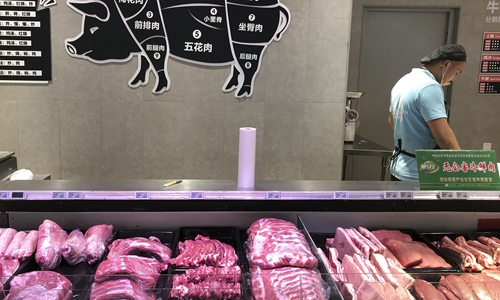HOME >> BUSINESS
Pork prices down in November: agriculture ministry
Source:Global Times Published: 2019/11/16 18:16:53

Photo:VCG
Pork prices in 16 provinces and cities have declined for two consecutive weeks, according to the Ministry of Agriculture and Rural Affairs on Saturday.
"The supply of hogs is the most prominent issue in China's agricultural market," the Minister of Agriculture and Rural Affairs Han Changfu said Friday.
"Since November, hog and pork prices have started to fall. In the future, with further implementation of supportive policies, hog production will gradually resume," he added.
As of Friday, the average price of pork in the wholesale market of agricultural products nationwide was 48.13 yuan per kilogram, down 0.9 percent from Thursday, according to official data.
In October, the inventory of sows in China has stopped falling and began to soar. Since November, the price of hogs and pork has started to fall. The output of poultry, beef, and mutton has increased considerably this year, and the supply in the meat market is generally guaranteed, according to Han.
"In October, due to the sharp rise in the prices of livestock and poultry products, the prices of other consumer goods were mixed, resulting in a serious lack of market confidence," Ma Wenfeng, a senior analyst at Beijing Orient Agribusiness Consultancy, told the Global Times on Saturday.
The minister said in the future, with further implementation of supporting policies, hog production will gradually resume.
"The influence of agricultural market price fluctuation on economy and society requires that China must attach great importance to agricultural production," Ma noted.
Pork prices rose since the outbreak of the African swine fever. In August and September, the prices increased by around 20 percent monthly, which analysts say boosted the consumer price index (CPI).
The rise in China's CPI was mainly driven by food prices lately, the impact of which will gradually fade in the second half of 2020, the central bank noted in a report released on Saturday.
It is expected that in the second half of 2020, the impact of food price rise on CPI will gradually fade, the carry-over effect on PPI will be smaller than that in 2019, and the gap between CPI and PPI is expected to narrow, said the People's Bank of China in its Q3 report on China's monetary policy implementation on Saturday.
CPI and PPI are important economic indicators of price changes in the consumer and production sectors during a period.
Since 2019, CPI in China has gradually increased from less than 2 percent at the beginning of the year to 3.8 percent in October, according to data released by the central bank.
"Face to face the current economic situation, set up production and consumer confidence is important to promote the healthy development of the economy and society," said Ma.
Global Times